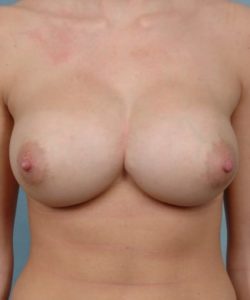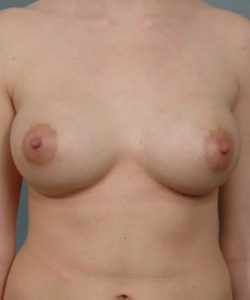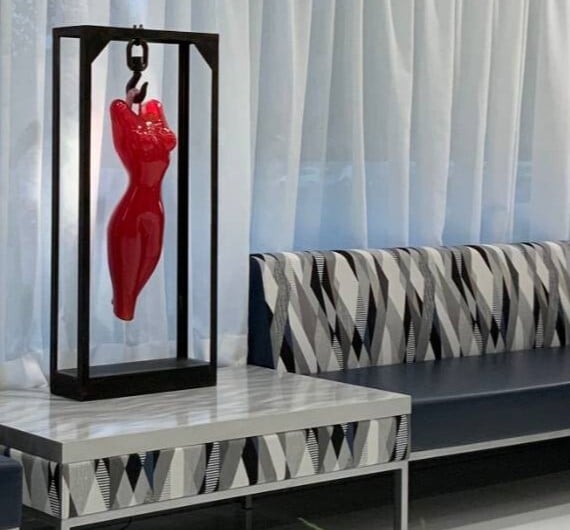Avoidance of Synmastia
The best way to treat synmastia is not to have it happen in the first place. Although synmastia is a form of implant malposition, and implant malposition can (and does) happen to any surgeon, there are some very simple ways to prevent synmastia.
1. Avoidance of placing too large an implant – This cannot be overemphasized. If the implant is too wide for the chest, then either the implant will be too far to the sides of the chest, or too far to the sides of the chest and towards the midline. If the implant is just too far to the midline, the breast will be excessively full medially and the nipples will be pointed outwards. If the implant is too large for the chest, the nipples will point in their normal direction, but the breasts will be too close in the midline. The above is especially true for a subglandular implant.
2. Preserve as much of the sternal attachment of the muscle as possible – When the implant is below the muscle, the muscle is a strong defense against synmastia. Releasing the muscle along the breastbone will allow the implant to protrude towards the midline.
Surgical Correction of Synmastia
Synmastia after subglandular augmentation: If the implants were placed above the muscle, correction of synmastia is relatively easy. During a subglandular (implant lies above the pectoralis muscle and below the breast gland itself) augmentation, a pocket is created under the breast and above the muscle. As the pocket dissection approaches the periphery of the breast, the actual amount of breast tissue becomes very thin, until there is just about only skin overlying the muscle. When dissecting towards the sternum (breastbone), if one strays too far towards the midline, the pocket may then continue further towards the midline than the overlying breast is situated. This will result in the implant potentially displacing too far towards the midline. If the dissection occurs medial to the outer edge of the sternum, the skin can now lift off the sternum. Now, consider this occurring from both sides. Now both implants can lie too close to the midline. The inner aspects of the breasts will now touch, but at the expense of the skin lifting off the sternum as well. So now, the deep crevasse that should lie between the breast and appear as a dark, vertical linear shadow now is a shallow, widened indent between the breasts, which is very unnatural in appearance. If the implant size chosen has a base diameter like, or slightly less that of the breast itself, then there is a chance that the implants may still lie in the proper location directly under the breast. It takes force to push the breasts towards the midline and lift the skin over the sternum. If there is no force from the outside of the breasts, then this won’t happen. However, now consider if the surgeon places an implant that fills the now over dissected, oversized pocket, that implant has no where to go and is forced to push towards the midline and elevate the skin over the sternum. See the example below:

Before

After
So now, the result is an unattractive synmastia and a very unhappy patient. The good news is that fixing this problem is relatively simple. We need to find some way to limit the inner border of the implant and keep it from moving any closer to the midline. Fortunately, there is a wonderful solution – the pectoralis muscle. This muscle lies along the entire sternum and when the implant is placed below it, its attachment to the sternum will maintain the inner border of the implant in the exact position you want it and prevent it from moving further towards the midline. So here, a “site change” where the implant is removed from the subglandular pocket above the muscle and placed into a new pocket created under the muscle solves the problem. Placing a few sutures into the old pocket to prevent migration of the implant back into that pocket is also useful. Lastly, if there is no capsule contracture, as in the case above, some of the normal implant capsule can also be “re-purposed” as a lower extension of the pectoralis major muscle to help keep the implant in its proper place. That is what was done in the case shown above.
Synmastia after submuscular augmentation: In this case, the repair of synmastia is a little more complicated, but correctable. In this case, the implant has been placed under the pectoralis muscle. This muscle, like all muscles, has an origin and an insertion. The origin is the fixed point the muscle is attached on one side, and the insertion is the point of attachment on another bone that is moved by the muscle. In the case of the pectoralis, the muscle is attached to the entire side of the sternum (breastbone) and the lower attachment to the sternum continues along the rib cage in a horizontal line for a few inches. The insertion of the pectoralis muscle is on the humerus (upper arm bone). When making an implant pocket under this muscle, only the horizontal portion of the muscle is separated from the underlying rib cage, never separate the muscle from the sternum (it is usually OK if the lower 1 -2 cm of sternal attachment is separated). If the sternal attachment of the muscle is detached during surgery, the implant can now push its way towards the midline. If the implants normally drop when the breast stretches, they can now move too close together.
The muscle barrier along the breastbone by definition is compromised. Most surgeons correct this problem by placing sutures up and down the medial (towards the breastbone) side of the pocket to limit the opening in that area and direct the implant to move more to the lateral side of the chest. This makes sense in theory but there are some issues with this technique. The sutures can be uncomfortable because they need to be placed into solid tissue on the chest wall so as to securely hold the suture. A suture needle will not pass through the ribs; one would have to utilize the fascia (overlying tissue) of the muscle between the ribs. There is also no guarantee that it will work. The suture line can disrupt, especially if there is pressure on it from the implant. It may be advantageous to reduce the implant size and consider opening up the lateral (outside) of the pocket (only if there is room to do so – you do not want excessive lateral protrusion of the implant because that doesn’t look good, either).
The best way that I know of to handle this situation is to create a new pocket below the muscle. There is now no natural barrier left intact to use to keep the implant in its normal position. In this case, the scar tissue capsule needs to be separated from the underside of the pectoralis muscle, but only so far towards the midline as where the muscle ends (where it was previously attached to the sternum) so that this new “neo-subpectoral” pocket can keep the implant in proper position. This is a much more tedious surgical procedure. This is done by peeling the breast and muscle off the scar tissue capsule, and creating the pocket to the proper dimensions. The implant is then inserted into this new (“neo-submuscular”) plane. By keeping the old scar tissue capsule below the implant, the implant cannot fall into the previous implant space. This may be hard to visualize, but with this technique, you do not need to rely on the integrity of a row of sutures placed into thin tissue with the implant pushing on it as you do in the neo-subpectoral technique described above. This technique is associated with a high degree of success and is not that difficult to perform.
Sections – Implant malposition/bottoming out of the breast
- Incorrect Development of the Pocket
- Correction of Incorrect Development of the Pocket
- Lower Pole Stretch / Inferior Implant Malposition
- Correction of Lower Pole Stretch / Inferior Implant Malposition
- Lateral Displacement / Lateral Implant Malposition
- Correction of Lateral Displacement / Lateral Implant Malposition
- Synmastia / Medial Malposition
- Correction of Synmastia / Medial Malposition
Prev Section: Explantation (Removal of implants) »
Next Section: Change of Implant Size »
Sections – Revision of Breast Augmentation
- Capsule contracture
- Explantation (Removal of implants)
- Implant malposition/bottoming out of the breast
- Bio-materials Used in Revision of Breast Augmentation – Strattice, GalaFLEX and GalaFORM
- Implant size change
- Change from textured to smooth implants
- Changing from saline to silicone gel filled implants
- Adding a breast lift later
Prev Chapter: Important Things to Consider When You Decide to Move Forward With Breast Augmentation »
Next Chapter: ALCL and Breast Implant Illness »
Chapters – Breast Augmentation Guide
- Intro to Breast Augmentation
- Motiva Breast Implants
- Five key decisions you need to make
- One-Day Recovery Breast Augmentation
- Anesthesia – General, Sedation or Local?
- Breast Lift (Mastopexy) with/without Implants or Fat
- What else should I know about breast augmentation?
- Important Things to Consider When You Decide to Move Forward With Breast Augmentation
- Revision of breast augmentation
- ALCL and Breast Implant Illness
Schedule A Consultation
Contact our Long Island office at 631.689.1100 for more information regarding repair of implant malposition.


